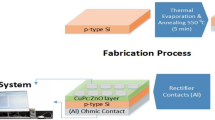Abstract
The effect of the NOA61 photopolymer organic interlayer on the electrical and dielectric properties of the Al/NOA61/p-Si/Al metal-polymer-semiconductor (MPS) device has been reported the first time. The device parameters of the device such as rectification ratio (RR), ideality factor (n), and barrier height (ΦB) were determined from the current–voltage (I–V) measurements according to thermionic emission theory (TE). Series resistance, RS, values were also calculated by Norde and Cheung methods in the range of 2.4–3 kΩ. According to the reverse bias I–V measurements, the current was governed by Frenkel–Poole Emission (FPE) in the entire region. The voltage-dependent capacitance (C) and the conductance (G/ω) measurements were investigated at particular frequencies between 20 kHz and 1 MHz. The dielectric constant (ε′), dielectric loss (ε″), loss tangent (tanδ), and the complex electric modulus (M) were calculated using the measured C and G parameters, and it was seen that the interface states and surface dipoles at the interfacial layer were effective in the behavior of the device in alternating current. Additionally, the morphological properties of the thin film were studied by scanning electron microscopy (SEM). We observed that (NOA61) organic interlayer may be a noticeable alternative to a variety of electronic applications.
















Similar content being viewed by others

Data availability
Not applicable.
References
S.M. Sze, Physics of Semiconductor Devices, 2nd edn. (Wiley, New York, 1981)
E.H. Rhoderick, R.H. Williams, Metal Semiconductor Contacts, 2nd edn. (Clarendon Press, Oxford, 1988)
M.E. Aydin, F. Yakuphanoglu, J.H. Eom, D.H. Hwang, Physica B 387, 239 (2007). https://doi.org/10.1016/j.physb.2006.04.012
S. Altindal, J. Farazin, G. Pirgholi-Givi, E. Maril, Y. Azizian-Kalandaragh, Physica B 582, 411958 (2020). https://doi.org/10.1016/j.physb.2019.411958
O. Gullu, S. Aydogan, A. Turut, Microelectron. Eng. 85, 1647 (2008). https://doi.org/10.1016/j.mee.2008.04.003
Ş Altındal, S. Karadeniz, N. Tuğluoğlu, A. Tataroğlu, Solid-State Electron. 47(10), 1847 (2003). https://doi.org/10.1016/S0038-1101(03)00182-5
O. Gullu, O. Pakma, A. Turut, J. Appl. Phys. 111, 044503 (2012). https://doi.org/10.1063/1.3684989
V.R. Reddy, Thin Solid Films 556, 300 (2014). https://doi.org/10.1016/j.tsf.2014.01.036
C. Tozlu, A. Mutlu, Synth. Met. 211, 99 (2016). https://doi.org/10.1016/j.synthmet.2015.11.023
A. Tataroğlu, Ş Altındal, Y. Azizian-Kalandaragh, Physica B 576, 411733 (2020). https://doi.org/10.1016/j.physb.2019.411733
S. Khalifeh, Polymers in Organic Electronics (ChemTec Publishing, Toronto, 2020). https://doi.org/10.1016/B978-1-927885-67-3.50007-9
Norland Products Incorporated, Norland Optical Adhesive 61 Data Sheet (Norland, Cranbury, 2009)
https://www.norlandprod.com/adhesives/NOA%2061.html. Accessed 22 Sept 2021
D. Chemisana, M.V. Collados, M. Quintanilla, J. Atencia, Appl. Energy 110, 227 (2013). https://doi.org/10.1016/j.apenergy.2013.04.049
T.M. Grant, K.L.C. Kaller, T.J. Coathup, N.A. Rice, K. Hinzer, B.H. Lessard, Org. Electron. 87, 105976 (2020). https://doi.org/10.1016/j.orgel.2020.105976
R. Guertin, M.-A. Bianki, C. Lemieux-Leduc, Y.-A. Peter, Sens. Actuators B 335, 129655 (2021). https://doi.org/10.1016/j.snb.2021.129655
P.A. Mohammed, Eur. Polym. J. 139, 109950 (2020). https://doi.org/10.1016/j.eurpolymj.2020.109950
W. Mönch, H. Zappe, Comprehensive Microsystems (Elsevier, Amsterdam, 2008). https://doi.org/10.1016/B978-044452190-3.00039-2
M. Montecchi, Q. Ingram, Nucl. Instrum. Methods Phys. Res. Sect. A 465, 329 (2001). https://doi.org/10.1016/S0168-9002(01)00678-7
R. Kaur, A. Arora, S.K. Tripathi, Microelectron. Eng. 233, 111419 (2020). https://doi.org/10.1016/j.mee.2020.111419
M. Koca, Z. Kudaş, D. Ekinci, S. Aydoğan, Mater. Sci. Semicond. Process. 121, 105436 (2021). https://doi.org/10.1016/j.mssp.2020.105436
H. Norde, J. Appl. Phys. 50, 5052 (1979). https://doi.org/10.1063/1.325607
S.K. Cheung, N.W. Cheung, Appl. Phys. Lett. 49, 85 (1986). https://doi.org/10.1063/1.97359
A. Tataroǧlu, Ş Altindal, M.M. Bülbül, Nucl. Instrum. Methods Phys. Res. Sect. A 568, 863–868 (2006). https://doi.org/10.1016/j.nima.2006.08.047
B. Gündüz, N. Turan, E. Kaya, N. Çolak, Synth. Met. 184, 73 (2013). https://doi.org/10.1016/j.synthmet.2013.10.002
E. Marıl, Physica B 604, 412732 (2021). https://doi.org/10.1016/j.physb.2020.412732
S. Meftah, M. Benhaliliba, M. Kaleli, C. Benouis, C. Yavru, A. Bayram, Physica B 593, 412238 (2020). https://doi.org/10.1016/j.physb.2020.412238
V.R. Reddy, V. Manjunath, V. Janardhanam, Y. Ho Kıl, C. Jong Cho, J. Electron. Mater. 43, 3499–3907 (2014). https://doi.org/10.1007/s11664-014-3177-3
V.R. Reddy, C. Venkata Prasad, K. Ravindranatha Reddy, Solid State Sci. 97, 105987 (2019). https://doi.org/10.1016/j.solidstatesciences.2019.105987
A. Tataroğlu, Ş Altındal, Microelectron. Eng. 85, 1866–1871 (2008). https://doi.org/10.1016/j.mee.2008.05.025
K. Deshmukh, S. Sankaran, B. Ahamed, K.K. Sadasivuni, K.S.K. Pasha, D. Ponnamma, P.S.R. Sreekanth, K. Chidambaram, Spectroscopic Methods for Nanomaterials Characterization (Elsevier, Amsterdam, 2017). https://doi.org/10.1016/B978-0-323-46140-5.00010-8
O. Pakma, N. Serin, T. Serin, Ş Altındal, J. Phys. D 41, 215103 (2008). https://doi.org/10.1088/0022-3727/41/21/215103
S. Karadas, S.A. Yeriskin, M. Balbaşı, Y. Azizian-Kalandaragh, J. Phys. Chem. Solids 148, 109740 (2021). https://doi.org/10.1016/j.jpcs.2020.109740
Y. Azizian-Kalandaragh, İ Yücedağ, G. ErsözDemir, Ş Altındal, J. Mol. Struct. 1224, 129325 (2021). https://doi.org/10.1016/j.molstruc.2020.129325
D. Akay, U. Gökmen, S. BilgeOcak, Mater. Chem. Phys. 245, 122708 (2020). https://doi.org/10.1016/j.matchemphys.2020.122708
E.H. Nicollian, J.R. Brews, MOS (Metal Oxide Semiconductor) Physics and Technology (Wiley, New York, 1982)
Acknowledgements
The authors would like to thank Muğla Sıtkı Koçman University Research and Application Center for Research Laboratories for their support.
Funding
The author did not receive support from any organization for the submitted work.
Author information
Authors and Affiliations
Contributions
ŞÖ participated in the conceptualization, methodology, data analysis, and reviewing and editing of the manuscript. NA participated in the methodology and reviewing and editing of the manuscript. OP participated in the supervision and reviewing and editing of the manuscript. AK participated in the investigation and data analysis.
Corresponding author
Ethics declarations
Conflict of interest
The authors have no conflict of interest to declare that are relevant to the content of this article.
Additional information
Publisher's Note
Springer Nature remains neutral with regard to jurisdictional claims in published maps and institutional affiliations.
Rights and permissions
About this article
Cite this article
Özden, Ş., Avcı, N., Pakma, O. et al. NOA61 photopolymer as an interface for Al/NOA61/p-Si/Al heterojunction MPS device. J Mater Sci: Mater Electron 32, 27688–27697 (2021). https://doi.org/10.1007/s10854-021-07150-4
Received:
Accepted:
Published:
Issue Date:
DOI: https://doi.org/10.1007/s10854-021-07150-4



